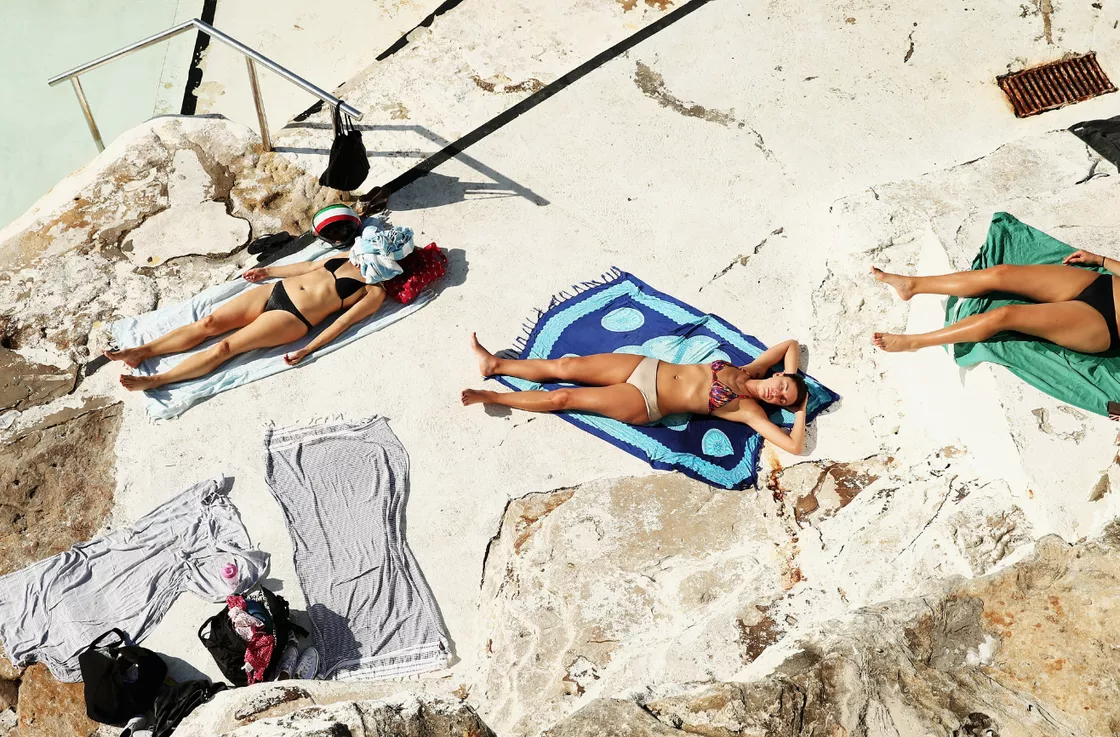Everything about sun protection.
Since most of us don’t work outside these days, it actually takes effort to get daily sun, rather than to avoid it.
Wellness Mama
To protect yourself from the sun, which gives you vitamin D, in order to fill yourself with vitamin D in pills. To protect yourself from the sun, which may cause a skin cancer, in order to be deficient in vitamin D, which helps to protect against many types of cancer. At the same time using creams that interfere with hormones and contain toxins, upsetting the balance again. And so on.
Every time I’m told that something is vital to me, I involuntarily wary. I’m also not a fan of the idea that one size fits all. If you need to protect yourself from the sun, take a sunscreen and apply it, isn’t that it? No, not so simple. So shall we apply that cream or not?
Introduction to ultraviolet light
Ultraviolet types:
Ultraviolet radiation is classified into three types, depending on the wavelength: UVA, UVB, UVC. The shorter the wave, the more harmful it is and at the same time penetrates the skin less. The atmosphere completely protects us from the most harmful UVC.
The atmosphere also filters most UVB, but some part is still able to penetrate the upper layers of the skin, and this is a much larger part than the nature intended, due to chemical damage of the ozone layer by humans. UVB is responsible for long-term tanning and exactly burning, promotes skin aging and skin cancer. And provides us with the so-called vitamin D.
The longest wave, UVA, is about 95% of all ultraviolet light that reaches the earth’s surface. It can penetrate into the deeper layers of the skin and are responsible for the immediate tanning effect, promote skin aging and wrinkles. It can also penetrate the glass. Recent studies have found that UVA can contribute to the development of skin cancer as well.
What affects the radiation power:
- time of year and time of day (peak – in the summer months of mid-latitudes and 4-6 hours around noon);
- latitude (ultraviolet level is higher closer to the equator);
- altitude (the higher, the less ultraviolet light is absorbed by the atmosphere);
- reflections from surfaces (most surfaces reflect ultraviolet light, thereby increasing its strength, for example, water, grass and soil reflect less than 10%, sand – 15%, sea foam – 25%, and snow – 50%);
- clouds and haze (as a rule, clouds reduce the permeability of ultraviolet light, but light or thin clouds can even increase its amount, so it is recommended to beware even on a cloudy day in the shade).
Sunburn
The more sunburns we get in a lifetime, the higher the risk of skin cancer. Children’s skin is especially sensitive, and sunburn should be avoided completely. How many burns an individual can safely survive is very individual: it depends on genetics (family history of the disease and skin color), time spent in the sun, the level of each skin burn, and so on. The easier your skin burns, the higher the risk.
Introduction to suncreen
SPF
The first thing we pay attention to when looking at a sunscreen bottle is the abbreviation SPF (sun protection factor), which indicates the level of protection of the skin from burning, more precisely from UVB rays, but doesn’t measure the level of protection from no less dangerous UVA rays. Therefore, dermatologists also recommend looking for the words “broad spectrum”, which denote protection from both types of rays. It is recommended to choose a product with at least SPF 30. If you are dealing with water and sweat, you should also choose a waterproof product that should protect for about 40 minutes in water or a very waterproof – 80 minutes.
In order for a sunscreen to be really effective, it’s necessary to use a proportion of 2 mg per 2 cm2 of the body and apply it every 2 hours. Most people use a quarter to a half of the required amount and do not renew protection in time, if they do that at all.
The SPF scale is not linear:
- SPF 15 blocks 93% of UVB
- SPF 30 blocks 97% of UVB
- SPF 50 blocks 98% of UVB.
Sunscreen vs sunblock
Some products protect the skin through chemical processes, and some block or reflect the sun, creating a physical barrier. The second type usually contains particles of titanium and/or zinc.
Sunscreens contain elements that require proof of safety. The long-term effect of the use of sunscreen is unknown to science.
Forms
- cream (best for dry skin, especially the face);
- lotion (used mainly for the body, they are lighter and less greasy);
- gel (best for hairy areas);
- sticks (for the skin around the eyes);
- spray (the easiest option for children, but you need to make sure that the child doesn’t inhale it, which is not easy at all).
Skin cancer
There are three main types of skin cancer: 2 types of carcinoma and melanoma. If detected in time, each of them is treated, and control of sunlight can reduce the risk of cancer. This includes the fact that a healthy amount of sunlight promotes good health and, in fact, reduces the risk of melanoma.
When you spend much of your day treating patients with terrible melanomas, it’s natural to focus on preventing them, but you need to keep the big picture in mind. Orthopedic surgeons, after all, don’t advise their patients to avoid exercise in order to reduce the risk of knee injuries.
Richard Weller
In the course of evolution, humans have learned to naturally protect themselves from solar radiation by producing melanin. While migrating further away from the tropics and resting from the sun in winter, organisms learned to produce less melanin to get what they needed from the sun, and began to produce much more protein, which retains vitamin D for later use. In the spring, as the sun grew stronger, they gradually accumulated sunlight. Sunburn was probably a rarity until modern times, when we closed our offices and began to burn ourselves on the beaches once a year. Such a sharp drop really sounds dangerous.
The best long-term research available shows that sunscreens have very little effect on melanoma, the most dangerous of skin cancers, and some components of sunscreen can even cause other forms of cancer.
Dangers and potential dangers
- nanoparticles of titanium dioxide and zinc oxide (there is a suspicion of their harm, but nothing confirmed so far, however, children for some reason can be given products containing only zinc oxide);
- paraaminobenzoic acid (PABA) and benzophenone products can cause skin irritation, including rashes and pimples;
- octinoxate and oxybenzone have estrogenic (female hormones) effects in cells and animal studies, as do some parabens (effects on humans have not yet been studied);
- avobenzone, oxybenzone, octocrylene and ecamsula are absorbed into the blood and remain there for some time (this was discovered by a study in 2019, and the effects of it have not yet been studied);
- vitamin A (many products contain it because it’s considered essential for the skin, but there are doubts about the appropriateness of vitamin A on the skin in direct sunlight, and more research is needed on this topic);
- leaving sunscreen in the sun can damage its formula, after which it will stop being effective (therefore, you cannot take it to the beach);
- coral reefs (oxybenzone contained in sunscreens is one of the factors that destroys coral reefs, in some parts of the world such suscreens are already prohibited by law, for example, in Hawaii);
- vitamin D (with proper application there is a risk of deficiency of this vitamin);
- addiction and dependence (there is an opinion about their possibility).
Vitamin D
Most likely, sunscreens also do not block vitamin D, because people mostly do not use them properly (often enough and in sufficient quantities), and therefore, hurray, they still get their vitamin D… and do not receive protection from ultraviolet light, and studies claim that the higher the SPF in the sunscreen, the more one tends to relax and ignore the rules of application.
However, what we are advised is the constant use of sunscreen, regardless of a place of the residence and a season (and people protect themselves, from head to toe, some even at home, including “protection” from the ‘blue light’, i mean with sunscreen; where did you take all thatvmoney from? ?) and supplementation with artificial vitamin D, which, however, shows a minimum to zero result. As I btw suspected.
The Australians realized that something was wrong already in 2005, their dermatologists officially stated that ultraviolet light has both beneficial and harmful effects on health, and you need to keep a balance so that the beneficial doesn’t turn into harmful. And the benefit is not only in obtaining vitamin D.
And that’s how, having common sense, we approach the question number 1.
How to protect yourself from the sun?
- take into account the peculiarities of their genetics, skin, lifestyle, environmental factors;
- limit exposure to the sun and avoid it from 10 to 16;
- try to gradually increase the amount of sun in your life;
- remember that surfaces (water, sand, grass, snow) reflect light, increasing the intensity of radiation;
- wear protective clothing (pants, long-sleeved T-shirts, sunglasses and hats; clothing is a separate topic, if desired, you can dive here);
- if necessary, use sunscreen (look for SPF30, a wide range, waterproof, consisting zinc oxyde; you can even make your own (you can’t test it at home, but you can be sure that it doesn’t contain poison; I like the idea of not putting on the skin things which I wouldn’t put inside);
- adjust your diet (greens, especially spinach, leeks, parsley, cilantro, lettuce, celery, broccoli; watermelon, apricots, grapefruit, pomegranate, all red fruits, berries; tomatoes and especially tomato paste contain lycopene, an antioxidant that can enhance the natural defenses of the skin from free radicals; dark chocolate, tea – antioxidants and anti-inflammatory; salmon, sardines, herring, seaweed, flax seeds / chia – omega3 sources, healthy saturated fats such as butter and coconut oil).
Sunlight triggers the release of a number of other important compounds in the body, not only nitric oxide but also serotonin and endorphins. It reduces the risk of prostate, breast, colorectal, and pancreatic cancers. It improves circadian rhythms. It reduces inflammation and dampens autoimmune responses. It improves virtually every mental condition you can think of. And it’s free.
Sources:
- https://www.who.int/uv/faq/whatisuv/en/index2.html
- https://www.vox.com/science-and-health/2018/6/25/17500704/sunscreen-skin-cancer
- https://www.badgerbalm.com/s-30-what-is-spf-sunscreen-sun-protection-factor.aspx
- https://www.mayoclinic.org/diseases-conditions/skin-cancer/symptoms-causes/syc-20377605
- https://www.mayoclinic.org/healthy-lifestyle/adult-health/in-depth/best-sunscreen/art-20045110
- https://www.outsideonline.com/2380751/sunscreen-sun-exposure-skin-cancer-science
- https://www.ewg.org/sunscreen/report/the-trouble-with-sunscreen-chemicals/
- https://www.gaia.com/article/10-ways-eat-your-sunscreen



